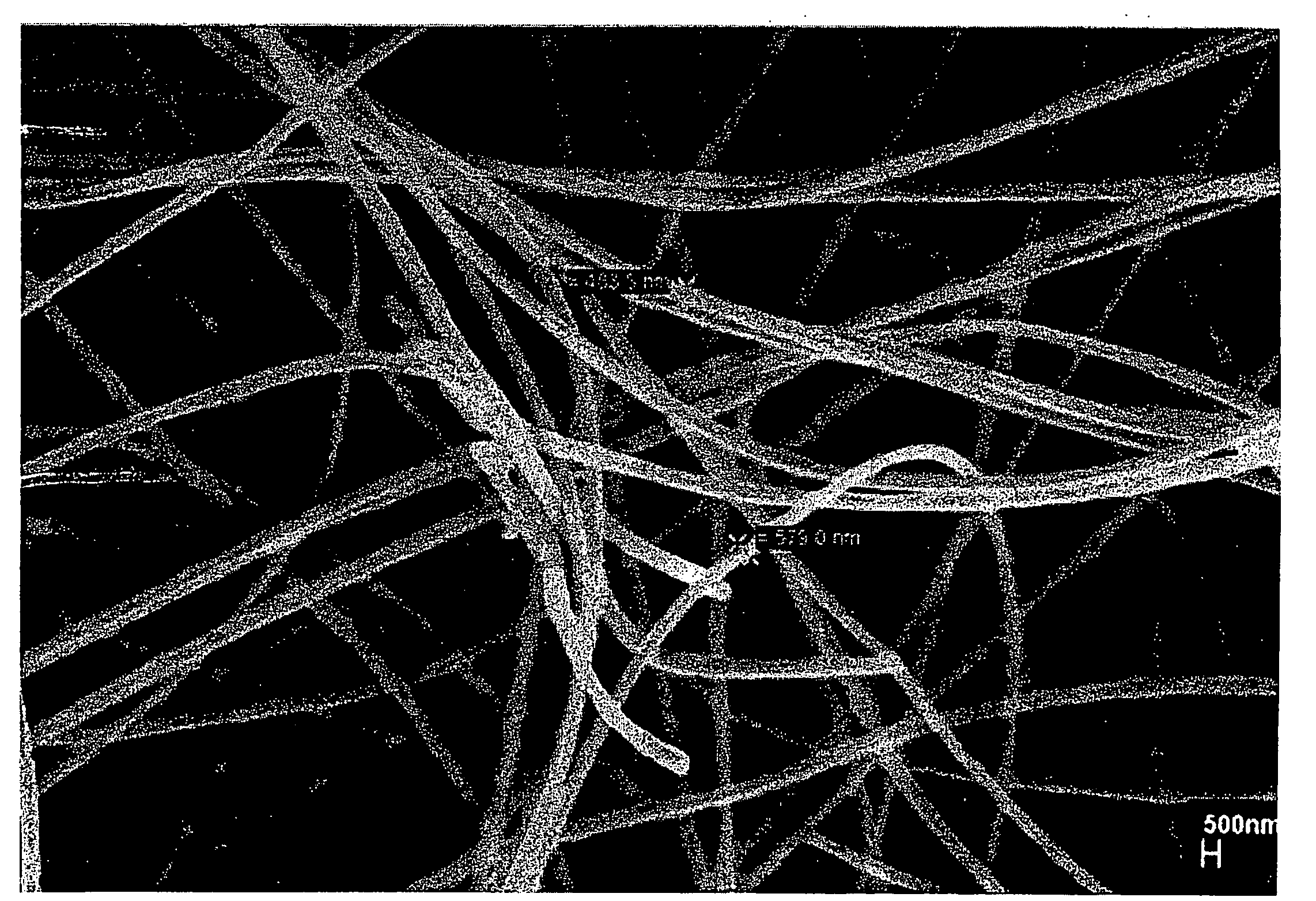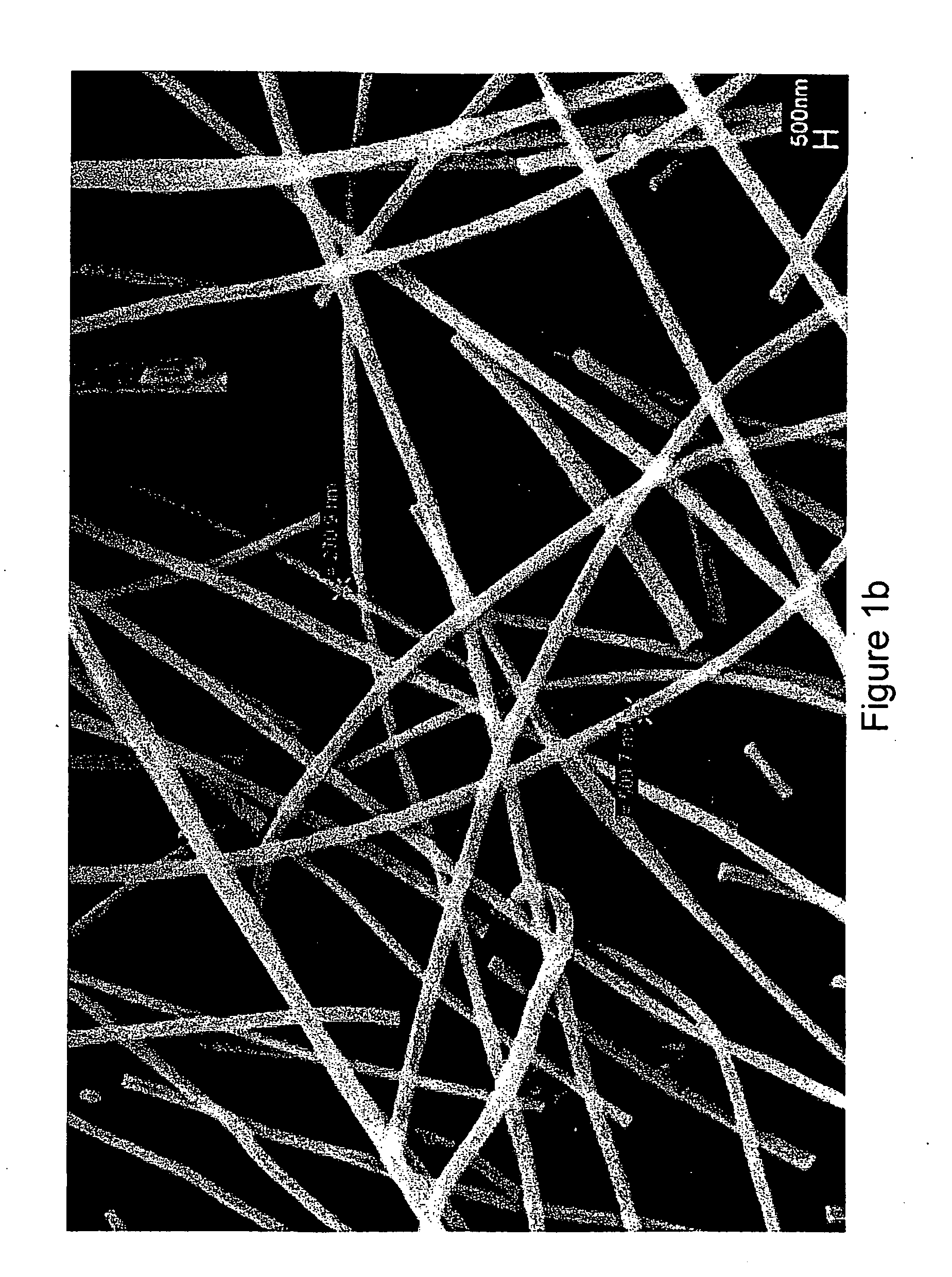Fibers and methods relating thereto
a technology of fibers and fibers, applied in the field of fiber technology and nanotechnology, can solve the problems that the process did not attract the attention of researchers
- Summary
- Abstract
- Description
- Claims
- Application Information
AI Technical Summary
Benefits of technology
Problems solved by technology
Method used
Image
Examples
example 1
Materials and Methods
[0077]Polymer fibers were injected using a 10 mL glass syringe with an 18 needle gauge (1.23 mm OD×0.83 mm ID (internal diameter)), a 22 needle gauge (0.7 mm OD×0.4 mm ID), or a 26 needle gauge (0.45 mm OD×0.1 mm ID) at a flow rate of about 0.05 mL / min as controlled using a KDS 210 pump (KD Scientific Holliston Inc., MA). One of ordinary skill in the art can recognize that the needle gauge may vary depending on the desired diameter and may range from 8-34 gauge. A high power supply, ES30P-5W (Gamma High Voltage Research, Ormond Beach, Fla.) was also used. The equipment was coupled to the needle tip through an alligator clip and a voltage difference of between 5-50 kV, and in particular, 15 kV was used, and the grounded target was placed at 24.5 cm from the needle tip, although distances from between 5 to 50 centimeters may also be used.
Scanning Electron Microscopy (SEM)
[0078]For SEM analyses, a Leo 435 VP (Leo Electron Microscopy Ltd) was used to ...
example 2
Electrospun PMMA Nanofibers
[0081]Polymer samples were prepared by dissolving 7.5 wt. % PMMA in a 1:1 THF:DMF solvent mixture. PMMA (350,000 g / mol; Alfa Aesar); THF and DMF (Sigma-Aldrich), used without further purification.
[0082]SEM micrographs of PMMA nanofibers obtained with needles with different internal diameters are presented in FIG. 1A-C. These fibers presented regular surface morphologies with a few nanofiber bundles being evident in FIGS. 1A-C. The resulting PMMA non-woven mats were analyzed (10-12 individual nanofiber diameters were measured) to calculate the average nanofiber diameter and standard deviation.
[0083]The thermogravimetric analysis (TGA) of PMMA samples in powder form and nanofibers are shown in FIG. 2, presenting all the samples a one step decomposition process. The TGA indicated an unexpected increase of about 40° C. in the onset decomposition temperature of PMMA from the powder form (about 266° C.) to the nanofiber (about 306° C.). Reports on TGA for polyme...
example 3
CNF-Reinforced Micro- and Nanofibers
[0086]PMMA (7.5%, 350,000 g / mol; Alfa Aesar) was dissolved in 1:1 THF / DMF. Next, 0.02 wt. % CNFs (vapor grown carbon nanofibers (Pyrograph III™) PR-24-RAW with diameters of 50-200 nm supplied by Applied Sciences, Inc. and purified according to the procedure reported by Lozano and collaborators (Lozano et al., 1999) were added and the solution was stirred vigorously for 20 hours.
[0087]In a separate experiment, 1.0 wt. % CHP was added to 7.5% PMMA in 1:1 THF / DMF, followed by addition of 0.002 wt. % CNFs. Vigorous stirring took place for 20 hours.
[0088]To avoid any nanoparticle sedimentation, each of these samples were then formed into micro- or nanofibers through the use of electrospinning as described above. Results may be seen in FIGS. 4 (SEM pictures) and 5 (TEM pictures).
PUM
| Property | Measurement | Unit |
|---|---|---|
| diameter | aaaaa | aaaaa |
| diameter | aaaaa | aaaaa |
| diameter | aaaaa | aaaaa |
Abstract
Description
Claims
Application Information
 Login to View More
Login to View More - R&D
- Intellectual Property
- Life Sciences
- Materials
- Tech Scout
- Unparalleled Data Quality
- Higher Quality Content
- 60% Fewer Hallucinations
Browse by: Latest US Patents, China's latest patents, Technical Efficacy Thesaurus, Application Domain, Technology Topic, Popular Technical Reports.
© 2025 PatSnap. All rights reserved.Legal|Privacy policy|Modern Slavery Act Transparency Statement|Sitemap|About US| Contact US: help@patsnap.com



